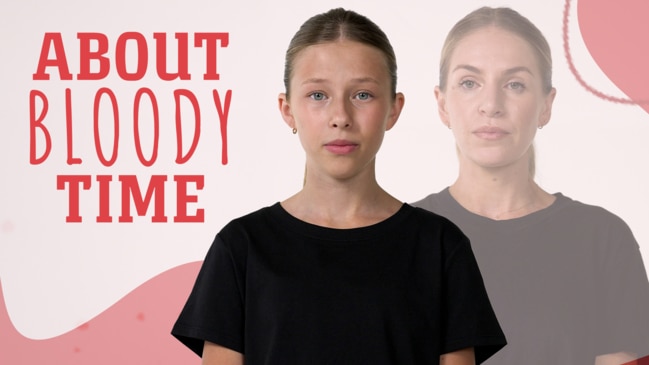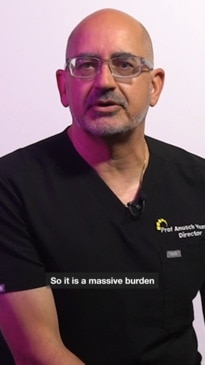Medicare rebates for women’s health care among the lowest in Australia
One million women with a chronic “silent” disease are being charged more than patients in other areas of health care, raising questions about an archaic health system.

An estimated one million Australians battling a chronic, “silent” disease are being gouged with staggering fees for inadequate treatment, and health experts say an outdated system “not set up to support women” is to blame.
Sufferers of endometriosis – an incurable disease that causes severe pelvic pain and infertility – are charged more than patients in other areas of healthcare with similarly complex conditions, with Medicare rebates on gynaecology consultations among the lowest in Australia.
Despite the prevalence of the disease, which is almost on par with the amount of people who have type 1 and 2 diabetes, specialists are ill-equipped to manage pain and rebates are so low there is no incentive to take time to provide thorough care. An initial gynaecologist appointment currently receives less than half the rebate of other specialist appointments dealing with issues as complicated as endometriosis.
This leaves the 1 in 9 women suffering from the condition with two options: short consults that barely scratch the surface, or huge out-of-pocket expenses.
Medicare is failing women and it’s About Bloody Time things changed. Around one million suffer from endometriosis. There is no cure. Help is hard to come by and in rural or regional areas, it’s virtually impossible. We are campaigning for longer, Medicare-funded consultations for endometriosis diagnosis and treatment.
Experts say the system only incentivises specialists to perform surgeries by offering rebates 200 times more than those applied to consultations – often leading to further surgeries and complications – rather than explore other treatment options.
Pain physician, researcher and advocate Associate Professor Susan Evans said gynaecologists had completed the same level of training as neurologists, gastroenterologists and cardiologists, but don’t share pay parity. And ultimately, the cost of that disparity is worn by patients.
A system ‘not set up for women’
“The average person (with endometriosis) has eight out of 14 different symptoms, which takes much more than a 15-minute appointment to sort out. But gynaes are seeing them in 10 minutes and hurrying onto the next patient,” Dr Evans said.
“The system is not set up to support women.
“Endometriosis patients have multiple symptoms, and they cross a range of organ systems, which would require significant history taking, discussion and education.
“But when Medicare was introduced, the plan was that you would make most of your money by doing the surgical procedure, and you didn’t have to spend time talking to anybody.”
A gynaecologist is paid the same by Medicare for a 15-minute appointment and a 60-minute appointment, with Medicare covering roughly 10 minutes of their time.
A standard “104” Medicare Benefits Schedule (MBS) item number used by a gynaecologist for an initial consult would see Medicare reimburse $81.30. In comparison, a gastroenterologist – a specialist in gastrointestinal diseases – would use a “132” item number, for which Medicare would provide a $250.65 rebate, which factors in the amount of care and time required to treat their patients holistically.
Dr Evans says the lack of compensation meant studying specialists were choosing not to go in the sector at all, leading to a shortage of women’s health specialists.
“We’ve got a massive workforce shortage in women’s pain. Nobody is going into this area,” she said.
“One, because it’s hard, but two, because you can’t make a living.
“It’s so unfair for these women with pain. Gynaes don’t like charging big gaps and being the ‘mean person’, but they have to keep their practice open, so they move out of this area.
“I have practitioners telling me, ‘I’d like to go into pelvic pain, but either I can’t afford it, I can’t keep my business open or my practice has pointed out that if I go into this area, I won’t be able to make a living.’
“If our health system adequately supported gynaecologists taking more of an interest in the range of symptoms and pain related conditions that women have, then it would be perceived as a reasonable area to work in as a gynaecologist.”
‘Can’t afford it’: Women priced out of treatment
It’s not just specialists who are opting out.
Sydney-based Kerrie Edwards, a mother of six-year-old twins, can’t afford the care required to address her Stage 4 endometriosis – the worst possible diagnosis.
Ms Edwards made national headlines in 2020 when she successfully lobbied the federal government to have an MBS item number reinstated for surgery for abdominal rectus diastasis, a condition she suffered after giving birth. Her fight to have her abdominoplasty recognised as “medically necessary” helped her undergo the life-changing procedure, but during this ordeal, she was quietly recovering from her first laparoscopy for endometriosis.
It’s a condition she’s put on the backburner her whole life, and more recently, the cost-of-living bite and exorbitant fees associated with managing it have made her feel it’s futile to bother.
“The pain is to the point where I’m in the foetal position, wailing on the bed,” Ms Edwards said.
“My doctor really wants me to go and have it looked at again to get a deep ultrasound, which is between $500 and $700 with a tiny bit of money back from Medicare.
“But with cost of living and our mortgage repayments having gone up $2000 in the last year, I just can’t afford it. And part of me doesn’t want to spend that money in case it’s useless.”
In 2022, the federal government made a raft of new changes to the MBS for gynaecology, introducing new item numbers which largely benefited the rebate on surgeries and procedures.
In November last year, the MBS introduced a new Level E item number providing 60-minute consults for general practitioners (GPs), which can, in theory, be used by gynaecologists.
However, the rebate is only a slight increase on the existing item, bumping it up to $98.40, and the gynaecologist would need to spend the full 60 minutes with a patient to earn that sum.
Compared to the current structure, which can see them earning $81.30 for three appointments within that same time frame, the small increase in rebate for one person is still a loss.

Surgery not always the answer
Former Channel 9 journalist Julie Snook is but one example of how poorly the system has let down women.
After having her first surgery aged 19, she had another 12 surgeries in the years afterwards, and now has such bad scarring she needs to have a hysterectomy – a complete removal of the uterus – at the age of 36.
“From my experience, I certainly don’t encourage people to be going in (for surgery) that many times,” Snook said.
“I think the first half of my journey, there wasn’t much around about it. The resources weren’t there for it, the funding wasn’t there for it, and the awareness wasn’t there for it. So I don’t feel like the health care system was there for it.
“The response seemed to be either to put me on drugs that were so extreme, and my body just couldn’t cope with them, or go in for surgery.”

Associate Professor Magdalena Simonis AM, a full-time GP and women’s health expert, said there was a place for surgical intervention with endometriosis patients, though stressed the importance of it being “necessary”.
“We want minimised intrusion and we want laparoscopies where they’re going to be life-changing for women,” Dr Simonis said.
“A laparoscopy is diagnostic and potentially therapeutic too. In terms of that, the cost effectiveness of laparoscopies is undoubtedly valid.
“But it is also a case of making a judgment call on who warrants a laparoscopy.
“Many times patients come out of their consultations feeling like they’ve just been seen as a person with endometriosis, but not holistically as a woman who has a family and a partner and a career.
“They feel that basically, the decision is either surgical or nonsurgical (hormonal treatment).”
‘Massive need’: Healthcare ‘travesty’ for regional, rural women
NSW MP Helen Dalton, the Member for Murray in the state’s south west, said there was a “massive need” for specialist endometriosis care, particularly in remote and regional areas where it’s virtually impossible to get in to see a general practitioner.
“The occurrence of (endometriosis) is really high. It’s the best kept secret. Our women are suffering in silence,” she said.
“Out here, we’re flat out to even have a doctor. There’ll be no doctors in the bush in five years. That’s how serious it is. It’s a travesty.
“I’ve got to wait at least six weeks to get a (GP) appointment. Let alone a gynaecologist.
“We haven’t got a gynaecologist in Griffith, I don’t think. Or an obstetrician. We have to go to Wagga, which is two hours’ (drive) from Griffith.
“Women are having babies on the side of the road. It’s bloody serious.”
Ms Dalton said the region used to have a women’s health centre, which had been phased out by the Liberal government.
“The previous government cut all kinds of women’s health that could be reignited,” she said.
“They cut us to the bone. We’ve come in from the coalition and they have cut us to the bone. “We should have people giving us some help with reproduction, we should have a women’s health centre in every major town.
“We are really regarded as third world as far as women’s health issues.
“The doctors just don’t want to come out here and work because they’re not supported.”
About Bloody Time is an editorial campaign by news.com.au that been developed in collaboration with scientists recommended by the Australian Science Media Centre, and with the support of a grant from the Walkley Foundation’s META Public Interest Journalism fund.







